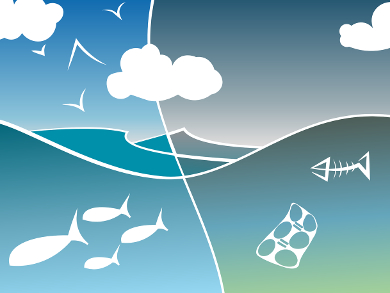According to a recent estimate, 4.8–12.7 million metric tons of plastic waste end up in the ocean each year, and this waste breaks into fragments with sizes of 0.5–5 mm. Little is known about the pathways and fate of these plastic fragments.
Alexandra ter Halle, Université Paul Sabatier, Toulouse, France, and colleagues analyzed 1275 plastic debris particles (5.8 g total mass) from the sea surface in the North Atlantic subtropical gyre (a system of rotating ocean currents). They found that thin flat fragments float with one face preferentially exposed to the sun. This face typically cracks more, but fewer organisms grow on it. Cubic particles, which roll in the water, exhibit the same characteristics on all faces, with fewer cracks and fewer attached organisms.
In 2012, Europeans used 1.5 times more polyethylene (PE) than polypropylene (PP), but the researchers found nine times as many PE particles as PP particles in the ocean. This could reflect differences in duration of use for various items, in where these items tend to be discarded, and in rates of photodegradation and fragmentation. The team notes a conspicuous lack of ultra-small plastic particles, and they call for new research to investigate what happens to particles smaller than 300 microns in the ocean.
- Understanding the Fragmentation Pattern of Marine Plastic Debris,
Alexandra ter Halle, Lucie Ladirat, Xavier Gendre, Dominique Goudouneche, Claire Pusineri, Corinne Routaboul, Christophe Tenailleau, Benjamin Duployer, Emile Perez,
Environ. Sci. Technol. 2016.
DOI: 10.1021/acs.est.6b00594
Also of Interest
- Plastic in Deep Seas,
Veronika Belusa,
ChemistryViews.org 2014.
Nearly all of Europe’s deep seas are polluted with litter, mainly with plastic - Ubiquitary Plastic Pollution,
Veronika Belusa,
Chemistryviews.org 2014.
More plastic particles than thought spread throughout the world’s oceans easier than thought




